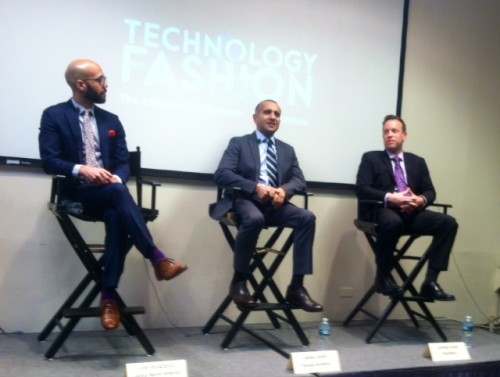Technology and Fashion: The Future is Now!

Robin Lewis and Fashion Group International hosted a terrific program last week in NYC on technology and fashion. More specifically, a panel of experts debated how to harness technology to design a unique customer experience as well as to create compelling product that meets speed, quality and cost targets.

The panel comprised: Anne Bridges, SVP of Technology and Customer Experience, Bloomingdales; Luis Velazquez, Director of Business Development for Lectra North America; Sahal Laher, Executive Vice President and Chief Information Officer, Brooks Brothers; and George Shaw, Head of R&D, RetailNext.
Some highlights from the discussion:
Robin Lewis kicked things off by stating the obvious: that recent technological advances continue to profoundly impact our business. “Today, the convergence of high-tech science and high-touch art elements is the equivalent of technology on steroids.” He noted that in addition to empowering consumers, the explosion of new technology and infinite apps has enabled retailers to respond to consumers in unprecedented ways. He asked the panel for their most successful new digital strategies.

Anne Bridges from Bloomingdales talked about tablets in fitting rooms that provide item details and item availability, with associates’ devices facilitating this interaction. “My biggest concern is that customer expectations are very high,” she confided.
Sahal Laher from Brooks Brothers spoke about personalizing the retail experience. “One model is not enough: consumers are individuals and since we have so much information on their purchases and their interactions, we’re capable of extensive personalization of both the product and the shopping experience.”
Luis Velazques from Lectra put the focus on product development. “I believe there’s not yet enough investment in the artistic component,” he maintained, “although digital technology has positively impacted textile design, 3D pattern-making and cutting equipment.”
George Shaw from RetailNext spoke about gathering date and presenting it to retailers in a meaningful way. “It’s about better understanding the interactions between sales associates and consumers.”
Laher then spoke about Beacon technology and Shaw brought up privacy issues. “We’d prefer to err on the side of conservative rather than creepy,” said Laher. “The future is personalization and transparency. These, and a nimble supply chain, since business has moved from two seasons to four.” He went on to talk about the lack of universal fashion trends. “It’s no longer about a single trend that takes over the whole market: different influences impact different lifestyles…” He hinted that Beacon technology can get out of control: “Imagine walking down Fifth Avenue and getting bombarded with hundreds of offers within a short period of time…”
Velazquez spoke about the changing role of buyer. “The pressure is on,” he maintained. “It’s tough to compile so much data in a meaningful way.” He also pointed out that working for a French company, he’s observed that the French are much more comfortable running out of inventory as opposed to American retailers’ obsession with staying in stock. “The French have trained their customers to buy it now or it might not be there tomorrow.”
Shaw sums it up this way: “The web has an unbelievable amount of data; it knows a lot about who you are and companies are employing armies of data analysts to sort it out. That’s what we’re going after in brick & mortar: to retrieve and optimize data in a similar way.”
Asked about the future of brick & mortar, Laher predicted with confidence: “In a few years, brick & mortar will have a much smaller footprint.” He also talked about Brooks Brothers providing the same level of customer service in outlet stores as they do in regular stores and a recent shift in the mindset of their sales associates to be more pro-active. “We use algorithms to provide recommendations at a success rate greater than 70 percent.”
A final change that has profoundly impacted business for the better: using social media for customer opinions early in the product development process to alleviate costly mistakes later on.








